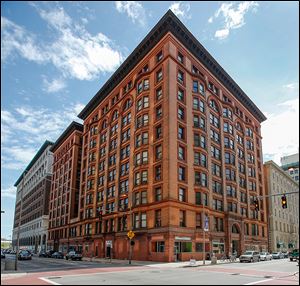
EDITORIALS
Saving Spitzer
Secure the Toledo landmark, and allow local officials and private developers to plan for its renovation
12/5/2013
The Spitzer Building
Toledo has severed another link with its past with the closing this week of the Spitzer Building, a downtown landmark for 117 years. But instead of merely lamenting the loss of one more piece of the city’s history, Mayor-elect D. Michael Collins and his transition team need to start now to brainstorm ways to encourage renovation of the 10-story building, as a first step to help revitalize the moribund central business district.
Click here to read more Blade editorials.
That starts with mothballing the building properly — a task that will have to be overseen for now by the administration of outgoing Mayor Mike Bell. The building must be secured effectively against vandalism and fire, and heated adequately. If it is allowed to deteriorate further, renovation will become that much more costly, and less likely.
The skyscraper at the corner of Huron and Madison has fallen on especially hard times since it passed from the Spitzer family’s ownership. A private-equity firm in California that bought the building nearly five years ago fell chronically behind on its property taxes, leading to foreclosure. The chief executive of the investment firm filed for bankruptcy last summer; the building is subject to a mortgage-foreclosure sale.
The Spitzer Building still has good bones to go with its storied history. Even when its occupancy rate fell below 30 percent, its tenants continued to include a number of prominent area law firms. Its ground-floor arcade, described as Toledo’s first enclosed mall, remained the home of a variety of shops during the building’s years of decline.
The still-elegant building can have a future as well as a past — one that can become a catalyst for a systematic plan of downtown redevelopment. Toledo City Council showed foresight when it voted unanimously in October to contribute $10,000 to maintenance of the building, on top of $5,000 allocated by the Bell administration, to accommodate renovation options.
The building’s court-appointed receiver, family member Patricia Spitzer, has been working with the Lucas County Land Bank to gain control of the building. Those efforts should be encouraged; since it launched three years ago, the land bank has shown its ability to work with private developers to rehabilitate vacant homes and commercial structures in Toledo, returning them to productive use and to tax rolls.
The last thing the Spitzer Building — or the city — needs is for the building to fall into the clutches of a vulture investor, who would squeeze out what remains of its value and then abandon it.
During this fall’s campaign, Mr. Collins accused the Bell administration of ignoring the needs of the Spitzer Building’s displaced tenants — a charge Mayor Bell denied. The next mayor now has an opportunity to show how he would do a better job not only of dealing with the aftermath of the building’s shutdown, but also of preparing for its return.
The fate of the Spitzer Building could do at least as much to determine the success of Mayor Collins’ economic development program as the revival (or lack of it) of the Marina District has reflected Mayor Bell’s approach to renewing Toledo. If private developers and city officials, working together, can’t figure out how to bring back the building, it’s hard to feel confident about the prospects of a broader downtown renaissance.